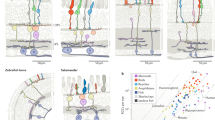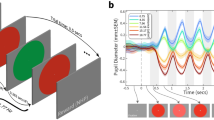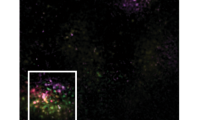Abstract
IT is nowadays possible to record the discharge of the retinal elements directly by leading off to electrodes from more or less isolated fibres of the optic nerve. The electrical impulses following upon illumination are the physiological means of communication between the retina and the higher centers. They are amplified and led to an oscillograph for photographic recording and at the same time listened to in a loud-speaker. This is the technique for which the well-known work of Prof. E. D. Adrian and his collaborators originally laid a solid basis. For isolation of the fibres in the optic nerve a method of micro-dissection around the blind spot has been developed by Hartline1 and a micro-electrode technique for picking up from the fibres inside the eye by Granit and Svaetichin2. The latter method is a great deal simpler and faster than the former, and for this reason it is the natural instrument for a rapid survey of the colour properties of a large number of single or grouped units in the response of the eye to illumination with spectral light of known energy content. Mammalian eyes can be studied with the micro-electrode as easily as eyes of the cold-blooded animals, to which the technique of micro-dissection is limited if it is to be used for analytical purposes. The animal is anaesthetized, cornea and lens removed, and the micro-electrode inserted with the aid of a micro-manipulator under suitable optical magnification.
This is a preview of subscription content, access via your institution
Access options
Subscribe to this journal
Receive 51 print issues and online access
$199.00 per year
only $3.90 per issue
Buy this article
- Purchase on Springer Link
- Instant access to full article PDF
Prices may be subject to local taxes which are calculated during checkout
Similar content being viewed by others
References
Hartline, Amer. J. Physiol., 121, 400 (1938).
Granit and Svaetichin, Upsala Là karef. Förh. N.F., 45, 161 (1939).
Lythgoe, J. Physiol., 89, 331 (1937).
Dartnell and Goodeve, NATURE, 139, 409 (1937).
Polyak, Arch. Ophthalm., 15, 477 (1936).
Wright, Proc. Roy. Soc., B, 115, 49 (1934).
Broda, Goodeve and Lythgoe, J. Physiol., 98, 397 (1940).
Author information
Authors and Affiliations
Rights and permissions
About this article
Cite this article
GRANIT, R. A PHYSIOLOGICAL THEORY OF COLOUR PERCEPTION. Nature 151, 11–14 (1943). https://doi.org/10.1038/151011a0
Issue Date:
DOI: https://doi.org/10.1038/151011a0
This article is cited by
-
Color perception using a single cone type with distributed maximum sensitivity
The Bulletin of Mathematical Biophysics (1964)
-
Two kinds of factor analysis?
Psychometrika (1954)
-
Current views on colour blindness
Documenta Ophthalmologica (1949)
-
The analysis of retinal elements by the micro-electrode technique
Documenta Ophthalmologica (1949)
-
Luminosity Curve of Trichromats
Nature (1946)
Comments
By submitting a comment you agree to abide by our Terms and Community Guidelines. If you find something abusive or that does not comply with our terms or guidelines please flag it as inappropriate.



